Jesshaines
New Member
- Joined
- Mar 29, 2022
- Messages
- 36
I'm trying to manage an out of balance pack. While living off grid.
I've come across a couple suggestions here and on the off-grid garage YouTube channel of basically using a light bulb to drain a single cell that's running.
Sorry, total noob! Can someone give a few more details of how actually to do this?
One person suggested a car headlight bulb. Does it matter that my cells are 3.2 volt nominal? Won't the headlight bulb be calibrated to run off 12 volts? Or maybe it will just shine dimly with the lower power supply....?
Also, do I need to worry about polarity of bulb matching cell when using this method?
Any help input suggestions welcome. Thank you
I've come across a couple suggestions here and on the off-grid garage YouTube channel of basically using a light bulb to drain a single cell that's running.
Sorry, total noob! Can someone give a few more details of how actually to do this?
One person suggested a car headlight bulb. Does it matter that my cells are 3.2 volt nominal? Won't the headlight bulb be calibrated to run off 12 volts? Or maybe it will just shine dimly with the lower power supply....?
Also, do I need to worry about polarity of bulb matching cell when using this method?
Any help input suggestions welcome. Thank you




